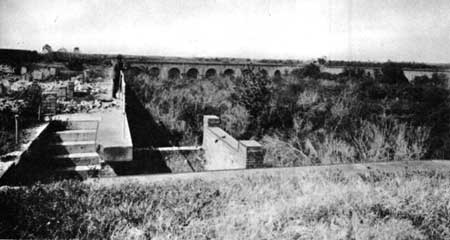|
FORT PULASKI National Monument |
 |

Abandoned and desolate.
Photo by Geoffrey King, 1925.
Cockspur Island After 1865
With the return of peace, the Corps of Engineers under the direction of General Gillmore undertook to modernize and strengthen Fort Pulaski. Between the years 1869 and 1872, they remodeled the demilune, constructing underground magazines and passageways and emplacements for heavy guns. Major changes were also planned for the main fortification, but, after digging a huge excavation in the north end of the parade ground and laying massive concrete piers, the job was abandoned. Proposals were already under consideration for a new coast artillery post on Tybee Island, which would take the place of Fort Pulaski.
After 1872 no further active military use of the fort was ever made, except briefly during the Spanish-American War when a small force was garrisoned there to man the guns that had been installed in the demilune and at Battery Horace Hambright, on the north shore of the island, and to operate the controls for electric mines in the mouth of the Savannah River. For many years the only inhabitants of the fort were an ordnance sergeant and a lightkeeper. After the great hurricane of 1891, when the sea rose 5 feet over the parade ground, a 2-story house for the lightkeeper was erected on the top of the fort.
In the first years of the 20th century, Fort Pulaski and the eastern part of Cockspur Island were totally abandoned. The moat around the fort and demilune filled with mud from the river; the tides swept over the neglected dikes and flooded the low-lying marshes. The parade ground became a veritable jungle and hundreds of snakes made their homes in the innumerable crevices in the fort's masonry. Infrequent parties of zealous hunters and hardy pilgrims, willing to wade through the soft marsh, were the only visitors.
Decontamination facilities to receive German prisoners of war were prepared in 1918 at the U. S. Quarantine Station on the west end of Cockspur Island, but the war ended before this installation was put to use.
Meanwhile, the War Department took the first step toward the preservation of Fort Pulaski, announcing on July 17, 1915, that this fortification had been selected to be a national monument under the American Antiquities Act. Further action was delayed by World War I. In 1918, Col. John Millis, District Engineer at Savannah, visited Fort Pulaski and was so impressed by the magnificence of the ruin that he recommended immediate preservation. The next district engineer, Col. F. W. Alstaetter, was equally interested in the project, and, largely through his efforts, the Savannah Board of Trade and other organizations began to seek national monument status for the fort. On January 7, 1924, Representative Charles G. Edwards, 1st District of Georgia, introduced a bill in Congress to bring about this desired result. The efforts of these individuals and organizations were rewarded on October 15, 1924, when Fort Pulaski was made a national monument by proclamation of President Calvin Coolidge.
The fort remained in desolate condition, however, until 1933 when the national monument was transferred by the War Department to the Department of the Interior, and the National Park Service began the development of the area.
The plan adopted in the restoration of Fort Pulaski was not to reproduce any one definite period in the history of the fortification, but rather to protect the structure from further deterioration by making essential repairs and to restore only where necessary to illustrate the use and history of certain features of the fort.
Original plans and specifications were available in the files of the War Department for practically all of the items of restoration and repair work undertaken. The restoration of the fort and the development of the national monument were accomplished with funds provided by the Public Works Administration and through the labor of the Civilian Conservation Corps. In 1938, Cockspur Island was joined to McQueens Island by the construction of a bridge across the South Channel of the Savannah River. From 1942 to 1947 the fort was closed to the public, when Cockspur Island, as the site of a Navy Section Base, again became an active part of the defense system of the United States.
Fort Pulaski is a large-scale outdoor exhibit. The main structure, together with outlying works, including demilune, drawbridges, ditches, and dikes, is a fine example of past military architecture. As a vivid reminder of past events it presents an important phase of our great national heritage.

|

|
|
Last Modified: Mon, Mar 4 2002 10:00:00 pm PDT |


